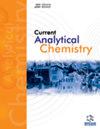A Fluorescent Probe for Hydrazine Based on 4-hydroxycoumarin with High Selectivity and Sensitivity
IF 1.7
4区 化学
Q3 CHEMISTRY, ANALYTICAL
引用次数: 0
Abstract
Background: Therefore, the development of reliable analytical techniques with high selectivity and sensitivity to detect hydrazine is required for the protection of human health and safety. Objectives: Traditional methods for detecting N2H4 are frequently time-consuming, less accurate, and unsuitable for the analysis of living systems. Numerous fluorescent probes for hydrazine have been produced and gained some valuable results recently. The creation of a simple fluorescent probe for hydrazine detection is the goal of this project Method: In this study, 300 µL of probe 3-methyl-2-oxo-2H-chromen-7-yl propionate (MOCP) was mixed with an equivalent amount of the solution of each analyte to obtain the measurement solution. Following a 10-minute room temperature incubation period, the fluorescence spectra of the resultant solution were recorded. Results: The fluorescence intensity of the probe was noticeably enhanced when N2H4 was added to the probe, but almost no fluorescence enhancement was observed when other competitive ions were added. Conclusion: A hydrazine fluorescent probe based on 4-hydroxycoumarin fluorophore was developed. The probe MOCP displayed high sensitivity and selectivity for hydrazine, with a color change from colourless to blue for detection by the naked eye. Moreover, it demonstrated a low detection limit of 20 nM and a fast reaction time of 30 s.一种基于 4-羟基香豆素的肼荧光探针,具有高选择性和高灵敏度
背景:因此,需要开发具有高选择性和高灵敏度的可靠分析技术来检测肼,以保护人类健康和安全。目标:检测 N2H4 的传统方法往往耗时长、准确性低,而且不适合对生命系统进行分析。最近已生产出许多肼的荧光探针,并取得了一些有价值的成果。本项目方法的目标是创建一种简单的肼检测荧光探针:在本研究中,将 300 µL 探针 3-甲基-2-氧代-2H-色烯-7-基丙酸酯(MOCP)与等量的各分析物溶液混合,得到测量溶液。室温孵育 10 分钟后,记录所得溶液的荧光光谱。结果:当探针中加入 N2H4 时,探针的荧光强度明显增强,但当加入其他竞争离子时,几乎没有观察到荧光增强。结论开发了一种基于 4-羟基香豆素荧光团的肼荧光探针。探针 MOCP 对肼具有很高的灵敏度和选择性,其颜色从无色变为蓝色,可用肉眼检测。此外,它的检测限低至 20 nM,反应时间短至 30 秒。
本文章由计算机程序翻译,如有差异,请以英文原文为准。
求助全文
约1分钟内获得全文
求助全文
来源期刊

Current Analytical Chemistry
化学-分析化学
CiteScore
4.10
自引率
0.00%
发文量
90
审稿时长
9 months
期刊介绍:
Current Analytical Chemistry publishes full-length/mini reviews and original research articles on the most recent advances in analytical chemistry. All aspects of the field are represented, including analytical methodology, techniques, and instrumentation in both fundamental and applied research topics of interest to the broad readership of the journal. Current Analytical Chemistry strives to serve as an authoritative source of information in analytical chemistry and in related applications such as biochemical analysis, pharmaceutical research, quantitative biological imaging, novel sensors, and nanotechnology.
 求助内容:
求助内容: 应助结果提醒方式:
应助结果提醒方式:


